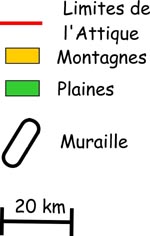Athens
Page 2
![]()
ATHENS
: ATTICA
Athens
Page 2 |
ATHENS
: ATTICA |
| In the fifth century before Christ, at the Apogee time, Athens was the most prosperous city in Greece; its county was called “Attica”: it is a peninsula of 2650 square kilometres which extends to the Aegean Sea and where there used to live about 300 000 inhabitants. Victories in the Medic Wars enforced a military supremacy, but the province had many resources as well: the Laurion silver mines and the magnificent marble of Pentelique. The sea trade reinforced/swelled/strengthened the power of the city; its harbour, the “Piree”, permitted profitable exchanges. Athens used to export marble, handicraft (weapons, pottery) and some agricultural exceeding goods: oil, wine. These liquids were shipped in earth-ware: ceramics, thus the prevailing role of potters in Athens. But the most job for the Greeks was farming; however, only citizens (born of an Athenian father and mother) were entitled to own some land. In spite of their attachment to their land, cereals were not produced in sufficient amount and wheat had to be imported. There was not enough of raw material such as wood or metal. |
|
 |